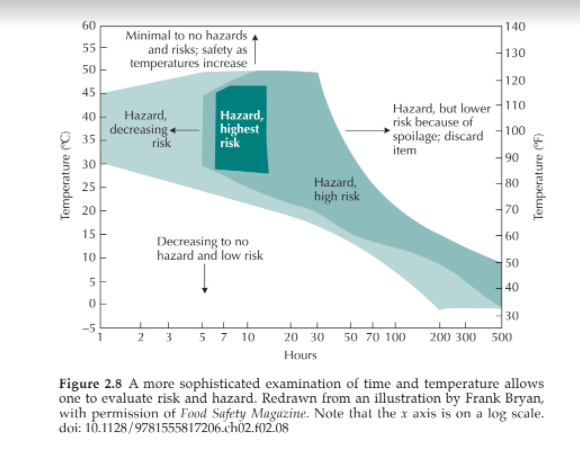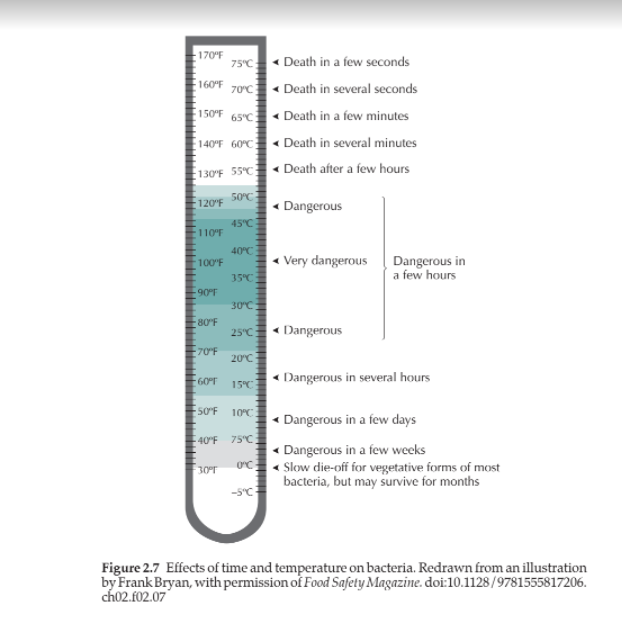Based on the figures given, 1. What range of time and temperature combinations poses the highest risk? 2. Explain briefly why hazards and risks decrease as temperature decreases from 55oC upwards. 3. Discuss briefly why after 100 hours, the risk decreases even if the temperature is optimal for growth of pathogens.
Based on the figures given, 1. What range of time and temperature combinations poses the highest risk? 2. Explain briefly why hazards and risks decrease as temperature decreases from 55oC upwards. 3. Discuss briefly why after 100 hours, the risk decreases even if the temperature is optimal for growth of pathogens.
Basic Clinical Lab Competencies for Respiratory Care: An Integrated Approach
5th Edition
ISBN:9781285244662
Author:White
Publisher:White
Chapter7: Phlebotomy
Section: Chapter Questions
Problem 2SEPT
Related questions
Question
Based on the figures given,
1. What range of time and temperature combinations poses the highest risk?
2. Explain briefly why hazards and risks decrease as temperature decreases from 55oC upwards.
3. Discuss briefly why after 100 hours, the risk decreases even if the temperature is optimal for growth of pathogens.
4. Write a conclusion explaining the relationship between time and temperature as illustrated in the two figures.

Transcribed Image Text:60
140
Minimal to no hazards ,
and risks; safety as
temperatures increase
55
130
50
120
45
Hazard, but lower 110
risk because of
*spoilage; discard
item
Hazard,
Hazard,
highest
risk
40
decreasing
risk
100
9 35
90
30
Hazard,
high risk
25
80
20아
70
15
60
Decreasing to no
hazard and low risk
10
50
5
40
30
-5
3
5 7 10
20 30 50 70 100 200 300 500
Hours
Figure 2.8 A more sophisticated examination of time and temperature allows
one to evaluate risk and hazard. Redrawn from an illustration by Frank Bryan,
with permission of Food Safety Magazine. Note that the x axis is on a log scale.
doi: 10.1128/9781555817206.chö2.f02.08
Temperature ("C)
Temperature ("F)

Transcribed Image Text:170°F
« Death in a few seconds
« Death in several seconds
« Death in a few minutes
« Death in several minutes
« Death after a few hours
75°C
160°F
70°C
150°F
65°C
140°F 60°C
130°F 55°C
50°C
« Dangerous
120'F
45°C
110°F
40°C
« Very dangerous
Dangerous in
a few hours
100'F
35°C
90F
30°C
80 F
25°C« Dangerous
70°F
20°C
60T
Dangerous in several hours
15°C
50 F
10°C
« Dangerous in a few days
40°F 75°C
« Dangerous in a few weeks
OC
« Slow die-off for vegetative forms of most
30
bacteria, but may survive for months
-5"C
Figure 2.7 Effects of time and temperature on bacteria. Redrawn from an illustration
by Frank Bryan, with permission of Food Safety Magazine. doi:10.1128/9781555817206.
ch02.f02.07
Expert Solution
This question has been solved!
Explore an expertly crafted, step-by-step solution for a thorough understanding of key concepts.
Step by step
Solved in 2 steps

Knowledge Booster
Learn more about
Need a deep-dive on the concept behind this application? Look no further. Learn more about this topic, biology and related others by exploring similar questions and additional content below.Recommended textbooks for you

Basic Clinical Lab Competencies for Respiratory C…
Nursing
ISBN:
9781285244662
Author:
White
Publisher:
Cengage

Case Studies In Health Information Management
Biology
ISBN:
9781337676908
Author:
SCHNERING
Publisher:
Cengage

Nutrition Through The Life Cycle
Health & Nutrition
ISBN:
9781337919333
Author:
Brown, Judith E.
Publisher:
Cengage Learning,

Basic Clinical Lab Competencies for Respiratory C…
Nursing
ISBN:
9781285244662
Author:
White
Publisher:
Cengage

Case Studies In Health Information Management
Biology
ISBN:
9781337676908
Author:
SCHNERING
Publisher:
Cengage

Nutrition Through The Life Cycle
Health & Nutrition
ISBN:
9781337919333
Author:
Brown, Judith E.
Publisher:
Cengage Learning,

Essentials Health Info Management Principles/Prac…
Health & Nutrition
ISBN:
9780357191651
Author:
Bowie
Publisher:
Cengage